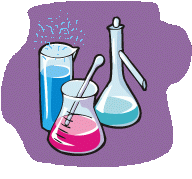


Description of experiment
Below follows a plain text transcript of the selected experiment.
![]()
Needed compounds:
-----------------
hydrochloric acid : HCl
potassium bromate : KBrO3
sodium chlorate : NaClO3
potassium chlorate : KClO3
Class:
------
elem=Br,Cl
redox
Summary:
--------
Chlorate and bromate react with hydrochloric acid, but bromate reacts more
vigorously. There also is a marked difference between potassium and sodium
chlorate. The sodium salt reacts more vigorous with hydrochloric acid, but
not as vigorous as potassium bromate.
Reactions of bromate are faster than reactions of chlorate, but for sodium
and potassium chlorate, the difference can be explained by the speed at
which the salt dissolves.
Description:
------------
Add some concentrated hydrochloric acid (appr. 30% by weight) to
1) solid potassium chlorate
2) solid sodium chlorate
3) solid potassium bromate:
Experiment (1) results in slow bubbling at the solid. The liquid becomes
intense yellow and a fairly intensely colored yellow/green gas mixture is
produced. It takes, however, several minutes before the gas mixture can be
observed in its full intensity.
Experiment (2) results in a fairly vigorous evolution of a gas mixture. The
liquid becomes intense yellow. This experiment shows the same reactions as
(1), but at a larger speed. The full intensity of the gas mixture now can be
observed in a matter of a few seconds.
Experiment (3) results in vigorous evolution of a green gas mixture. This
gas mixture has a stronger green hue than that, evolved in experiments (1)
and (2), where the gas mixture is more yellow. The intensity of the color
of the gas mixture is comparable to that of experiments (1) and (2).
Remark:
Experiments (1) and (2) result in formation of mixtures of Cl2 and ClO2.
Experiment (3) results in a mixture of Cl2 and Br2 (possibly forming BrCl).
![]()